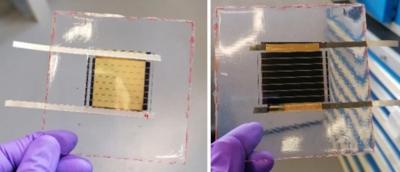The CEA at INES has reported the design of flexible perovskite solar modules with a surface area of 11.6 cm2 and a power conversion efficiency of 18.9% (stabilized efficiency > 18.5%). This performance is said to be a world record for flexible perovskite modules over 10 cm2.
Perovskite-based modules before and after flexible encapsulation. Image credit: CEA
For some applications, the use of flexible substrates may be attractive for single-junction perovskite technology as it opens the way to high-speed, low-temperature printing processes. Thus, it becomes possible to use low cost substrates whereas inorganic flexible technologies, such as CIGS, require higher temperature processes and substrates that are more expensive. Many teams around the world are trying to meet the challenges of making larger area devices with sufficient stability for real-life applications. This is one of the tasks standing before partners of the European APOLO project, as part of which these results were obtained.
These flexible perovskite solar modules have been obtained at low temperature on low cost substrates (PET) and with a very simple structure composed of 5 layers including electrodes. The displayed performances are obtained after encapsulation (also flexible). The stability of these devices has been tested under damp heat conditions (85°C, 85%RH), according to the standards used in silicon technologies. A stability of several hundreds of hours was obtained (400 to 800h according to encapsulation) considering a standard objective of 1000h.
To achieve this result, the CEA has worked on
- The optimization of the stack of layers that make up the cell,
- The use of a 3-step laser process to produce the module
- The development of a flexible encapsulation process that is fully compatible, without initial loss, with highly gas-barrier materials.
The European APOLO project (European Union’s Horizon research and innovation program), which finances this work, is coming to an end.
Modules will be interconnected in series to obtain high voltages and will be tested according to building standards by Flexbrick company, member of Apolo consortium. In addition, stability tests of encapsulated flexible modules under real outdoor conditions are currently being carried out.
In addition, these modules are currently being tested at the Fraunhofer Institute ISE, also a partner in the APOLO project, for indoor applications. These tests already showed power conversion efficiencies of up to 24.5% at very low illumination (500 lux). Certification is being considered.


